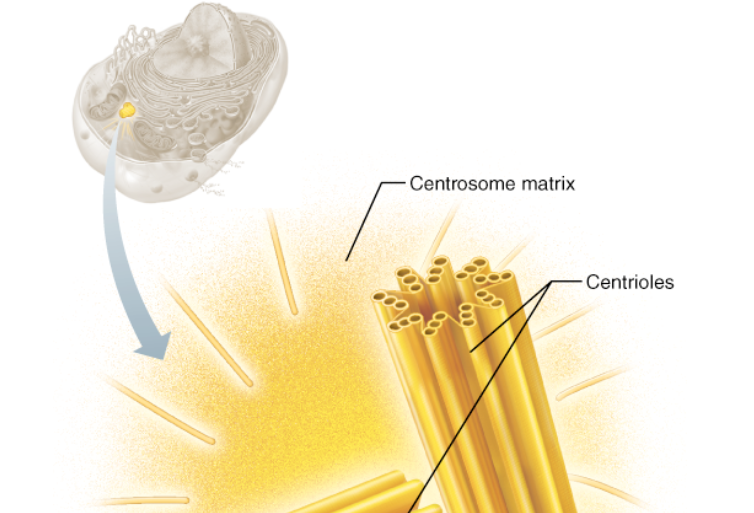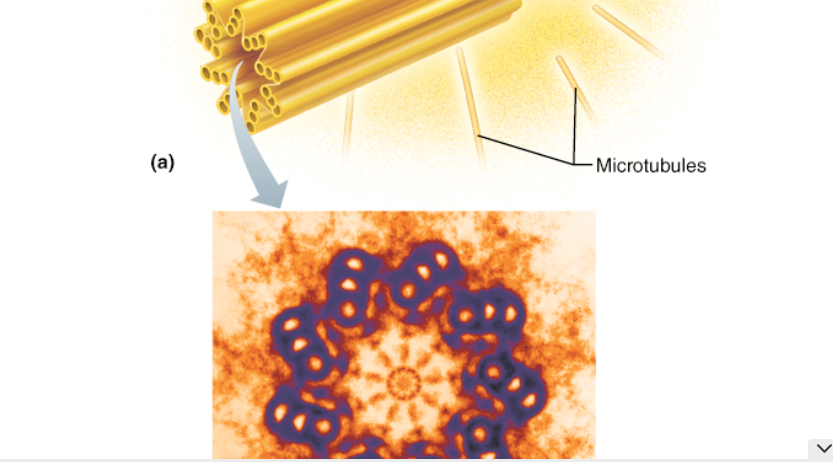
Anatomy & Physiology
5th Edition
ISBN: 9780321861580
Author: Marieb, Elaine N.
Publisher: Pearson College Div
expand_more
expand_more
format_list_bulleted
Concept explainers
Textbook Question
Chapter 3, Problem 19CYU
Compare the functions of lysosomes and peroxisomes.



Figure 3.22 Centrioles.
(a) Three-dimensional view of a centriole pair oriented at right angles, as they are usually seen in the cell. The centrioles are located in an inconspicuous region to one side of the nucleus called the centrosome, or cell center.
(b) An electron micrograph showing a cross section of a centriole
Expert Solution & Answer
Want to see the full answer?
Check out a sample textbook solution
Students have asked these similar questions
Molecular Biology
Please help with question. thank you
You are studying the expression of the lac operon. You have isolated mutants as described below. In the presence of glucose, explain/describe what would happen, for each mutant, to the expression of the lac operon when you add lactose AND what would happen when the bacteria has used up all of the lactose (if the mutant is able to use lactose).5. Mutations in the lac operator that strengthen the binding of the lac repressor 200 fold
6. Mutations in the promoter that prevent binding of RNA polymerase
7. Mutations in CRP/CAP protein that prevent binding of cAMP8. Mutations in sigma factor that prevent binding of sigma to core RNA polymerase
Molecular Biology
Please help and there is an attached image. Thank you.
A bacteria has a gene whose protein/enzyme product is involved with the synthesis of a lipid necessary for the synthesis of the cell membrane. Expression of this gene requires the binding of a protein (called ACT) to a control sequence (called INC) next to the promoter.
A. Is the expression/regulation of this gene an example of induction or repression?Please explain:B. Is this expression/regulation an example of positive or negative control?C. When the lipid is supplied in the media, the expression of the enzyme is turned off.Describe one likely mechanism for how this “turn off” is accomplished.
Molecular Biology
Please help. Thank you.
Discuss/define the following:(a) poly A polymerase (b) trans-splicing (c) operon
Chapter 3 Solutions
Anatomy & Physiology
Ch. 3 - Summarize the four key points of the cell theory.Ch. 3 - How would you explain the meaning of a generalized...Ch. 3 - What basic structure do all cellular membranes...Ch. 3 - Why do phospholipids, which form the greater part...Ch. 3 - What is the importance of the glycocalyx in cell...Ch. 3 - Prob. 6CYUCh. 3 - What is the energy source for all types of...Ch. 3 - What determines the direction of any diffusion...Ch. 3 - What are the two types of facilitated diffusion...Ch. 3 - What happens when the Na+-K+ pump is...
Ch. 3 - As a cell grows, its plasma membrane expands. Does...Ch. 3 - Prob. 12CYUCh. 3 - Which vesicular transport process allows a cell to...Ch. 3 - What process establishes the resting membrane...Ch. 3 - Prob. 15CYUCh. 3 - What term is used to indicate signaling chemicals...Ch. 3 - Which organelle is the major site of ATP...Ch. 3 - What are three organelles involved in protein...Ch. 3 - Compare the functions of lysosomes and...Ch. 3 - How are microtubules and microfilaments related...Ch. 3 - Prob. 21CYUCh. 3 - Prob. 22CYUCh. 3 - If a cell ejects or loses its nucleus, what is its...Ch. 3 - What is the role of nucleoli?Ch. 3 - What is the role of nucleoli?Ch. 3 - If one of the DNA strands being replicated reads...Ch. 3 - During what phase of the cell cycle is DNA...Ch. 3 - What are three events occurring in prophase that...Ch. 3 - Codons and anticodons are both three-base...Ch. 3 - How do the A, P, and E ribosomal sites differ...Ch. 3 - What is the role of DNA in transcription?Ch. 3 - What is the importance of ubiquitin in the life of...Ch. 3 - Prob. 33CYUCh. 3 - The smallest unit capable of life by itself is (a)...Ch. 3 - Prob. 2RQCh. 3 - Prob. 3RQCh. 3 - The term used to describe the type of solution in...Ch. 3 - Osmosis always involves (a) a selectively...Ch. 3 - Prob. 6RQCh. 3 - Prob. 7RQCh. 3 - The endocytotic process in which a sampling of...Ch. 3 - Prob. 9RQCh. 3 - The nuclear substance composed of histone proteins...Ch. 3 - The information sequence that determines the...Ch. 3 - Mutations may be caused by (a) X rays, (b) certain...Ch. 3 - The phase of mitosis during which centrioles each...Ch. 3 - Final preparations for cell division are made...Ch. 3 - The RNA synthesized on one of the DNA strands is...Ch. 3 - The RNA species that travels from the nucleus to...Ch. 3 - If DNA has a sequence of AAA, then a segment of...Ch. 3 - A nerve cell and a lymphocyte are presumed to...Ch. 3 - Prob. 19RQCh. 3 - Explain why mitosis can be thought of as cellular...Ch. 3 - Contrast the roles of ER-bound ribosomes with...Ch. 3 - Cells lining the trachea have whiplike motile...Ch. 3 - Name the three phases of interphase and describe...Ch. 3 - Comment on the role of the sodium-potassium pump...Ch. 3 - Differentiate between primary and secondary active...Ch. 3 - Cell division typically yields two daughter cells,...
Knowledge Booster
Learn more about
Need a deep-dive on the concept behind this application? Look no further. Learn more about this topic, biology and related others by exploring similar questions and additional content below.Similar questions
- Molecular Biology Please help with question. Thank you in advance. Discuss, compare and contrast the structure of promoters inprokaryotes and eukaryotes.arrow_forwardMolecular Biology Please help with question. Thank you You are studying the expression of the lac operon. You have isolated mutants as described below. In the absence of glucose, explain/describe what would happen, for each mutant, to the expression of the lac operon when you add lactose AND what would happen when the bacteria has used up all of the lactose (if the mutant is able to use lactose).1. Mutations in the lac repressor gene that would prevent the binding of lactose2. Mutations in the lac repressor gene that would prevent release of lactose once lactose hadbound3. Normally the lac repressor gene is located next to (a few hundred base pairs) and upstreamfrom the lac operon. Mutations in the lac repressor gene that move the lac repressor gene 100,000base pairs downstream.4. Mutations in the lac operator that would prevent binding of lac repressorarrow_forwardYou have returned to college to become a phylogeneticist. One of the first things you wish to do is determine how mammals, birds, and reptiles are related. Like any good scientist, you need to consider all available data objectively and without a preconceived “correct” answer. In pursuit of that, you should produce a phylogenetic tree based only on morphological features that show birds and mammals are more closely related. You will then produce a totally different tree, also using morphological features, that shows birds and reptiles are more closely related. Do not forget to include all three groups in both your trees. Based solely off the trees you produce, which relationship would you consider the more likely and why? Once you have answered that question, provide a brief summary of the “modern” understanding of the relationship between these three groups.arrow_forward
- true or false, the reason geckos can walk on walls is hydrogen bonding between their foot pads and the moisture on the wall.arrow_forwardBiology laboratory problem Please help. thank you You have 20 ul of DNA solution and 6X DNA loading buffer solution. You have to mix your DNA solution and DNA loading buffer before load DNA in an agarose gel. The concentration of the DNA loading buffer must be 1X in the DNA and DNA-loading buffer mixture after you mix them. For that, I will add _____ ul of 6X loading buffer to the 20 ul DNA solution.arrow_forwardBiology lab problem To make 20 ul of 5 mM MgCl2 solution using 50 mM MgCl2 stock solution and distilled water, I will mix ________ ul of 50 mM MgCl2 solution and ________ ul of distilled water. Please help . Thank youarrow_forward
- Biology Please help. Thank you. Biology laboratory question You need 50 ml of 1% (w/v) agarose gel. Agarose is a powder. How would you make it? You can ignore the volume of agarose powder. Don't forget the unit.TBE buffer is used to make an agarose gel, not distilled water. I will add _______ of agarose powder into 50 ml of distilled water (final 50 ml).arrow_forwardAn urgent care center experienced the average patient admissions shown in the Table below during the weeks from the first week of December through the second week of April. Week Average Daily Admissions 1-Dec 11 2-Dec 14 3-Dec 17 4-Dec 15 1-Jan 12 2-Jan 11 3-Jan 9 4-Jan 9 1-Feb 12 2-Feb 8 3-Feb 13 4-Feb 11 1-Mar 15 2-Mar 17 3-Mar 14 4-Mar 19 5-Mar 13 1-Apr 17 2-Apr 13 Forecast admissions for the periods from the first week of December through the second week of April. Compare the forecast admissions to the actual admissions; What do you conclude?arrow_forwardAnalyze the effectiveness of the a drug treatment program based on the needs of 18-65 year olds who are in need of treatment by critically describing 4 things in the program is doing effectively and 4 things the program needs some improvement.arrow_forward
- I have the first half finished... just need the bottom half.arrow_forward13. Practice Calculations: 3 colonies were suspended in the following dilution series and then a viable plate count and microscope count was performed. Calculate IDF's, TDF's and then calculate the CFU/mL in each tube by both methods. Finally calculate the cells in 1 colony by both methods. Show all of your calculations in the space provided on the following pages. 3 colonies 56 cells 10 μL 10 μL 100 μL 500 με m OS A B D 5.0 mL 990 με 990 με 900 με 500 μL EN 2 100 με 100 μL 118 colonies 12 coloniesarrow_forwardDescribe and give a specific example of how successionary stage is related to species diversity?arrow_forward
arrow_back_ios
SEE MORE QUESTIONS
arrow_forward_ios
Recommended textbooks for you
 Human Physiology: From Cells to Systems (MindTap ...BiologyISBN:9781285866932Author:Lauralee SherwoodPublisher:Cengage Learning
Human Physiology: From Cells to Systems (MindTap ...BiologyISBN:9781285866932Author:Lauralee SherwoodPublisher:Cengage Learning Concepts of BiologyBiologyISBN:9781938168116Author:Samantha Fowler, Rebecca Roush, James WisePublisher:OpenStax College
Concepts of BiologyBiologyISBN:9781938168116Author:Samantha Fowler, Rebecca Roush, James WisePublisher:OpenStax College Human Heredity: Principles and Issues (MindTap Co...BiologyISBN:9781305251052Author:Michael CummingsPublisher:Cengage Learning
Human Heredity: Principles and Issues (MindTap Co...BiologyISBN:9781305251052Author:Michael CummingsPublisher:Cengage Learning Biology 2eBiologyISBN:9781947172517Author:Matthew Douglas, Jung Choi, Mary Ann ClarkPublisher:OpenStax
Biology 2eBiologyISBN:9781947172517Author:Matthew Douglas, Jung Choi, Mary Ann ClarkPublisher:OpenStax Anatomy & PhysiologyBiologyISBN:9781938168130Author:Kelly A. Young, James A. Wise, Peter DeSaix, Dean H. Kruse, Brandon Poe, Eddie Johnson, Jody E. Johnson, Oksana Korol, J. Gordon Betts, Mark WomblePublisher:OpenStax College
Anatomy & PhysiologyBiologyISBN:9781938168130Author:Kelly A. Young, James A. Wise, Peter DeSaix, Dean H. Kruse, Brandon Poe, Eddie Johnson, Jody E. Johnson, Oksana Korol, J. Gordon Betts, Mark WomblePublisher:OpenStax College

Human Physiology: From Cells to Systems (MindTap ...
Biology
ISBN:9781285866932
Author:Lauralee Sherwood
Publisher:Cengage Learning

Concepts of Biology
Biology
ISBN:9781938168116
Author:Samantha Fowler, Rebecca Roush, James Wise
Publisher:OpenStax College

Human Heredity: Principles and Issues (MindTap Co...
Biology
ISBN:9781305251052
Author:Michael Cummings
Publisher:Cengage Learning

Biology 2e
Biology
ISBN:9781947172517
Author:Matthew Douglas, Jung Choi, Mary Ann Clark
Publisher:OpenStax

Anatomy & Physiology
Biology
ISBN:9781938168130
Author:Kelly A. Young, James A. Wise, Peter DeSaix, Dean H. Kruse, Brandon Poe, Eddie Johnson, Jody E. Johnson, Oksana Korol, J. Gordon Betts, Mark Womble
Publisher:OpenStax College

Biology - Intro to Cell Structure - Quick Review!; Author: The Organic Chemistry Tutor;https://www.youtube.com/watch?v=vwAJ8ByQH2U;License: Standard youtube license